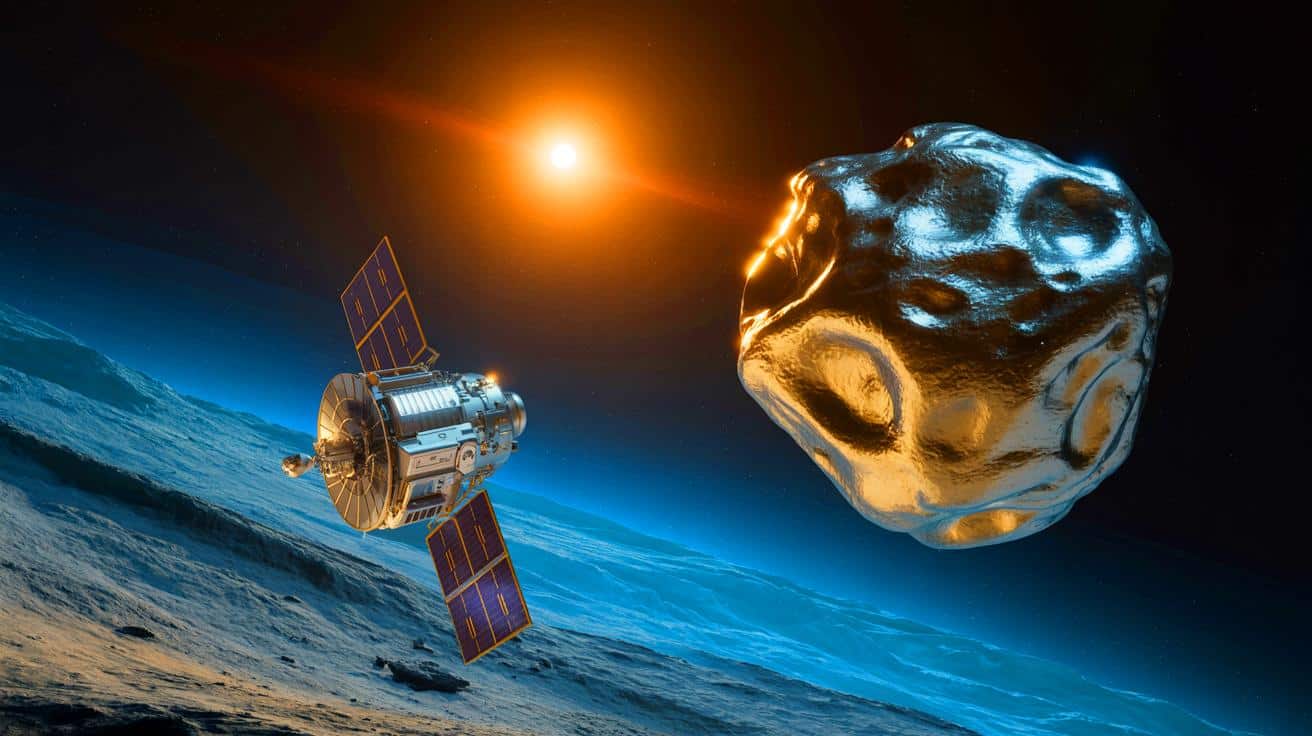IN A NUTSHELL
🪙 NASA’s mission to asteroid 16 Psyche aims to explore its potential $700 quintillion in metals.
🔍 The mission seeks to uncover planetary formation secrets rather than harvesting cosmic riches.
🚀 Technological advancements include an experimental laser communication system for future space exploration.
🌌 The exploration highlights the value of knowledge over raw resources in understanding cosmic phenomena.
In an era of scientific marvels, NASA’s upcoming mission to the asteroid 16 Psyche stands out as a remarkable endeavor. This cosmic body, located between Mars and Jupiter, is believed to hold a staggering $700 quintillion worth of metals, enough to hypothetically endow each person on Earth with $93 billion. However, the mission is not about acquiring wealth but rather unlocking the secrets of planetary formation. As NASA prepares to explore this celestial phenomenon, the mission promises to offer insights that might challenge our understanding of both cosmic and economic principles, pushing the boundaries of human knowledge in the process.
The Paradox of Cosmic Wealth
The initial reaction to the wealth of 16 Psyche is one of awe and excitement. Imagining an astronomical amount of resources within reach could easily lead to visions of untold prosperity. However, the reality of economics quickly dampens such dreams. Simply put, if a resource becomes overly abundant, its value diminishes significantly. The concept here is straightforward: true wealth arises from the ability to create and innovate, not merely from possessing raw materials.
Noah Smith, a seasoned journalist, aptly noted, “Wealth mostly doesn’t come from big hunks of metal. It comes from the ability to create things that satisfy human desires.” Possessing a large quantity of metal, even precious ones, doesn’t automatically translate to wealth unless it can be transformed into something of real value. The asteroid 16 Psyche, measuring approximately 140 miles wide, is composed of iron, nickel, and gold in unprecedented proportions. Yet, the real challenge lies in leveraging these resources effectively.
Beyond Cosmic Treasure: Will Psyche Rewrite the Story of How Planets Are Born?
Contrary to the idea of a cosmic treasure hunt, NASA’s mission to Psyche is driven by profound scientific objectives. The asteroid is thought to be the exposed core of an ancient planet, potentially offering clues about the early formation of planetary bodies like Earth. By studying its composition and magnetic field, scientists hope to gain insights into the processes that shaped our solar system.
This mission also marks a significant milestone as NASA’s first attempt to study a metallic asteroid in detail. Previous missions have primarily focused on rocky or icy bodies. The technological advancements accompanying this mission are noteworthy as well. Launched aboard a Falcon Heavy rocket, the spacecraft is equipped with cutting-edge instruments, including an experimental laser communication system. This could revolutionize data transmission between Earth and other planets, paving the way for more efficient space exploration in the future.
When Abundance Kills Value: Will Psyche Prove That Knowledge Is the Real Gold?
The exploration of Psyche underscores a fundamental economic principle: abundance can diminish value. Gold, for example, derives its worth from its scarcity. An influx of gold would likely reduce its economic significance, relegating it to a mere industrial material. This concept echoes the history of diamonds, once considered rare until De Beers managed to control their supply and create an enduring narrative around their value.
The advertising slogan “A Diamond Is Forever” transformed diamonds into symbols of eternal love, elevating their worth beyond the stone itself. Similarly, it is improbable that any marketing campaign could maintain the value of vast quantities of gold from Psyche in the market. However, the knowledge derived from the asteroid’s exploration could far exceed the monetary value of its metals. Such insights might reshape our understanding of planetary science, offering lessons that extend beyond material wealth. In this context, even a seemingly unrelated innovation like the diamond solar cell serves as a reminder that human ingenuity often holds more potential than raw resources.
“NASA Told Us We Had 72 Hours” Before The Anomaly Beneath Earth’s Crust Reaches Critical Mass
The Future of Space Exploration and Economic Realities
NASA’s journey to 16 Psyche is a testament to human curiosity and our quest for knowledge. While the mission will not bring back tangible riches, it offers the potential for invaluable scientific discoveries. Understanding the core of Psyche could provide clues to the mysteries of planetary formation and evolution, contributing significantly to our comprehension of the solar system.
Moreover, the mission highlights the broader economic realities of space exploration. As we venture further into the cosmos, the challenge lies not in acquiring resources but in utilizing them wisely. This perspective encourages a reevaluation of how we perceive value and wealth, emphasizing innovation and creativity over mere accumulation. The mission to Psyche serves as a reminder that the true wealth of the universe lies in its mysteries, waiting to be unveiled and understood.
As we stand on the cusp of this remarkable journey, the implications of NASA’s mission extend beyond scientific inquiry. It challenges us to rethink our approach to resources and value, both on Earth and in space. What new insights will we gain from Psyche, and how will they shape our future understanding of wealth and knowledge in the cosmos?
This article is based on verified sources and supported by editorial technologies.
Did you like it? 4.6/5 (28)

